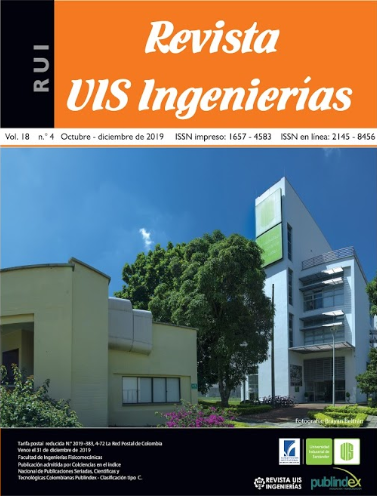Failure detection in a pressure vessel using acoustic emissions technology
Published 2019-09-16
Keywords
- GLP,
- AE damage detection,
- acoustics emissions,
- microseismic activity,
- pressure container
How to Cite
Copyright (c) 2019 Revista UIS Ingenierías

This work is licensed under a Creative Commons Attribution-NoDerivatives 4.0 International License.
Abstract
The acoustic emission (AE) technique was implemented to monitor different failure stages in steel cylinders used to store Liquefied Petroleum Gas (LPG). Experiments in two containers with external and internal defects subjected to a hydrostatic test were carried out. The severity of the faults was progressively increasing through the different stages to study the microseismic activity. The experimental tests allowed checking the Kaiser and Felicity effects. Additionally, it was observed that an increase in the severity of the failure depicts an increase in the number of hits, counts and energy values detected. The evolution of the acoustic activity for the different failure stages established the container's structural integrity, proving that AE allows evaluating its entire condition.
Downloads
References
[2] C. Hellier, Handbook of nondestructive evaluation, 2nd ed. McGraw-Hill, 2001.
[3] T. M. Roberts and M. Talebzadeh, “Acoustic emission monitoring of fatigue crack propagation,” J. Constr. Steel Res., vol. 59, no. 6, pp. 695–712, 2003, doi: 10.1016/S0143-974X(02)00064-0.
[4] H. Mazille, R. Rothea, and C. Tronel, “An acoustic emission technique for monitoring pitting corrosion of austenitic stainless steels,” Corros. Sci., vol. 37, no. 9, pp. 1365–1375, 1995, doi: 10.1016/0010-938X(95)00036-J.
[5] C. Ennaceur, A. Laksimi, C. Hervé, and M. Cherfaoui, “Monitoring crack growth in pressure vessel steels by the acoustic emission technique and the method of potential difference,” Int. J. Press. Vessel. Pip., vol. 83, no. 3, pp. 197–204, 2006, doi: 10.1016/j.ijpvp.2005.12.004.
[6] J. Meriaux, M. Boinet, S. Fouvry, and J. C. Lenain, “Identification of fretting fatigue crack propagation mechanisms using acoustic emission,” Tribol. Int., vol. 43, no. 11, pp. 2166–2174, 2010, doi: 10.1016/j.triboint.2010.06.009.
[7] O. Skawinski, P. Hulot, C. Binétruy, and C. Rasche, “Structural IntegritCylinders by Acoustic y Evaluation of CNG Composite Emission Monitoring,” J. Acoust. Emiss., vol. 26, 2008.
[8] A. R. Bunsell and A. Thionnet, Health monitoring of high performance composite pressure vessels, 7th ed. Elsevier, 2018.
[9] J. Catty, “Acoustic Emission Testing of Buried Pressure Vessels Implementation on a 16000 m3 gas storage unit,” J. Acoust., vol. 33, pp. 292–306, 2016.
[10] J. A. Lara Magallanes and M. Sánchez, “Emisión Acústica: Método de Inspección No Destructivo Para La Evaluación De Componentes Soldados,” México D.F., 2001.
[11] C. M. Ortega and R. E. Juárez, “Análisis del informe de resultados de ensayo de Emisión Acústica en base a lo establecido en al código ASME Boilers and Presure Vessels Code (BPVC) Sección V Artículo 12 2007,” in VII Congreso Regional de ENDE , 2009, p. 9.
[12] B. R. A. Wood and R. W. Harris, “Structural integrity and remnant life evaluation of pressure equipment from acoustic emission monitoring,” Int. J. Press. Vessel. Pip., vol. 77, no. 2–3, pp. 125–132, 2000, doi: 10.1016/S0308-0161(99)00093-9.
[13] S. J. Ternowcheck, T. J. Gandy, M. V. Calva, T. Patterson, and ASTM, “Documento Técnicoinspección Por Emisión Acústica Y Ultrasonidopara La Integridad Mecanica De Estructuras,” 1998.
[14] F. Rauscher, “Laboratory experiments for assessing the detectability of specific defects by acoustic emission testing,” in 28th European Conference on Acoustic Emission Testing, 2008.
[15] ASTM, Standard Practice for Acoustic Emission Monitoring of Structures During Controlled Stimulation. ASTM Compass, 2013.
[16] ASTM, Standard Guide for Mounting Piezoelectric Acoustic Emission Sensors. ASTM Compass, 2017.
[17] ASTM, Standard Practice for Characterizing Acoustic Emission Instrumentation. ASTM Compass, 2015.
[18] ASTM, Standard Guide for Determining the Reproducibility of Acoustic Emission Sensor Response. ASTM Compass, 2015.
[19] ASTM, Standard Guide for Acoustic Emission System Performance Verification. ASTM Compass, 2016.
[20] S. J. Vahaviolos, Acoustic emission : standards and technology update. ASTM, 1999.
[21] A. Danyuk, I. Rastegaev, E. Pomponi, M. Linderov, D. Merson, and A. Vinogradov, “Improving of Acoustic Emission Signal Detection for Fatigue Fracture Monitoring,” Procedia Eng., vol. 176, pp. 284–290, 2017, doi: 10.1016/j.proeng.2017.02.323.
[22] MERCOSUR, “Ensayos de cilindros de acero sin costura por emisión acústica,” Aendur, 2005
[23] Vallen Systeme, “AE Testing (AT) Fundamentals, Equipment, Data Analysis (Overview),” Munich, 2000.
